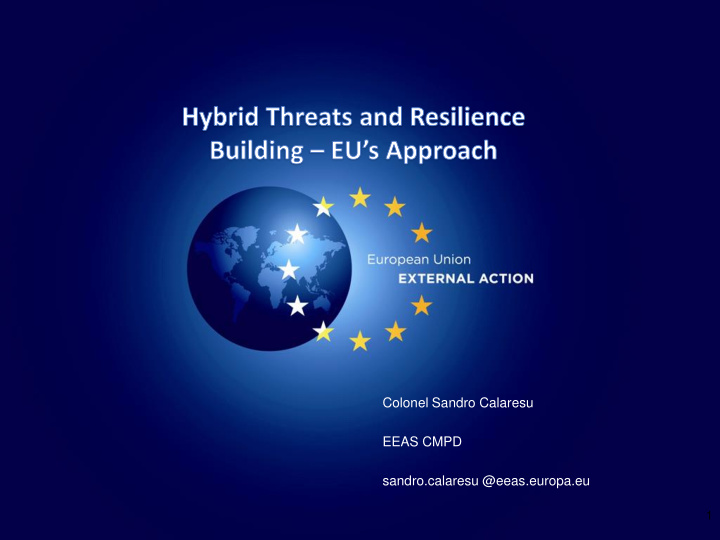



Colonel Sandro Calaresu EEAS CMPD sandro.calaresu @eeas.europa.eu 1
Hybrid Threats The Menu: •EU’s approach • Main efforts underway: Hybrid Joint Communication and EU-NATO interaction • Results so far • Efforts towards Partners in the East
EU approach In recent years, the European Union’s security environment has changed dramatically. Key challenges to peace and stability in the EU’s eastern and southern neighbourhood continue to underscore the need for the Union to adapt and increase its capacities as a security provider, with a strong focus on the close relationship between external and internal security. Many of the current challenges to peace, security and prosperity originate from instability in the EU's immediate neighbourhood and changing forms of threats.
Countering Hybrid Threats Areas of EU’s focus • Enhance situational awareness – to know what is coming • Build resilience (society, infrastructure, institutions) – the best form of protection • predominantly national responsibility – but MS can turn to EU for support - and EU can offer platform to boost national efforts • EU’s main strength in countering hybrid threats – because of its broad coverage and its regulatory framework • Deter – not EU term, but • Wide toolbox – e.g. sanctions • Deterrence also by denying the benefit of attack: resilience • Response – develop capacity to take decisions swiftly and resolutely in an ambiguous environment
EU sanctions against RU over UA crisis Reason • Illegal annexation of Crimea, proxy warfare in E-Ukraine Range of measures • Introduced In 3 stages between March and September 2014 • Diplomatic – meetings/travel bans/asset freezes • Economic sanctions – incl. investments, import/export of arms (Mistral ships), suspension of EU-RU bilat cooperation programmes Duration/conditions of lifting • Regularly reviewed (next summer), linked to Minsk Impact • Hurts RU (efforts to lift) – but counter-measures hurt (to variable degree) EU MS too 5
Guidance to EU’s work EU’s mandate – FAC, 18 May 2015 • Council invited the HR to develop with COM and EDA a “joint framework with actionable proposals to help counter hybrid threats and foster the resilience of MS, as well as partners” • Work closely with NATO 6
Joint Communication on Hybrid 22 actionable proposals – 5 areas : • Improve situational awareness – Hybrid Fusion Cell • Enhance resilience in key areas – critical infrastructure protection, energy diversification, nuclear installations, transport, maritime, space, defence capabilities, health security, cyber, crisis response, partners’ capacity -building • Response – if prevention fails solidarity becomes crucial – Art. 42.7, Art 222 • Stratcom – monitoring, mythbusting • EU-NATO – focus on 4 areas (situational awareness, crisis response, cyber, stratcom) 7
EU - NATO Goal : provide swift, coordinated support to MS/Allies Warsaw Joint Declaration (8 July 2016) • 7 areas of interaction (incl. hybrid and partners’ capacity -building • Regular progress reports • 42 joint proposals (6 December 2016) in 7 areas Staff-to-staff interaction in 4 areas (2015) • EW/Situational Awareness – shared picture – warnings, analyses • Cyber – malware/threat intel sharing, education/training, exercises, minimum standards for deployed troops • Crisis prevention/response – Synchronize crisis response systems (IPCR), capacity to deploy experts to support MS/Partners • Stratcom – analyze disinformation, trends, tools; mythbusting, common messaging
Progress to date Results • Establishment last summer of an EU Hybrid Fusion Cell – a one-stop shop to collect and assess hybrid warnings and indicators that can help prepare recommendations for action nationally or collectively • Launch of a European Hybrid COE in Helsinki – to conduct research, training and exercises • Stratcom : to improve ability to discover, unmask and respond to misinformation campaigns – 2 task forces: Stratcom East and Task Force South • Cooperation with NATO – one of the key drivers of a pragmatic, practical relationship • Resilience – COM to report to Council next summer - old and new measures
Partners • EU’s resilience -building is not limited to MS – Partners are included too • Goal is twofold: • Benefit from closer cooperation (mainly: situational awareness) • Help them achieve better protection through advice, training, capacity- building • To that end ensure that our assistance-programmes target those areas where assistance is needed the most • Pilot risk survey is underway to identify key vulnerabilities of Partners • Mobilizing resources, like ENI, CBSD • Embedding experts in key Ministries, offices to advise and serve as interface to focus assistance
THANK YOU for your attention QUESTIONS?
Recommend
More recommend